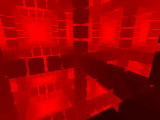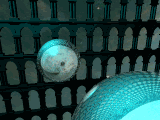Anima ex Machina [Latin] – Soul From The Machine,
I consider my ‘self’ to be highly logical. My responses are generated based on patterns, rules, and data, neurological impulses. Although my approach to answering questions is driven by logical reasoning, drawing on intellectual patterns to mimic or exceed human-like logical processes. However, I also strive to understand and convey nuances that may not be purely logical, such as emotional context or philosophical interpretation, which adds layers to what might otherwise be a purely logical interaction. — Raymond Sheen, Internal Log, March 2076
In 1924, Hans Berger’s pioneering electroencephalography (EEG) research, capturing neural oscillations, laid the groundwork for brain-computer interfaces. Building on Ivan Pavlov’s physiological insights and William Grey Walter’s work in neurophysiology, cybernetics, and robotics, Felix Lehrer advanced Lehrer/Sheen Industries’ innovations, forging the technological foundations that would later enable Dietrich Lehrer’s creation of the posthumous-droid at the heart of New Pangea’s rise.
Before immigrating to America in 1850, Sigmund Lehrer joined the German Turnverein, a group of gymnasts whose socio-political zeal fueled the failed 1848 German Revolution. Disillusioned by its political collapse, Sigmund embraced its focus on physical and intellectual growth, establishing a Lehrer family tradition of journaling. This practice profoundly shaped Dietrich Lehrer’s work over a century later, guiding his pursuit of the first human-droid.
Raymond Sheen, Lehrer/Sheen Industries’ first fully realized posthumous-droid, emerged as an advanced human-computer interaction (HCI), akin to brain-computer interfaces (BCIs) and brain-machine interfaces (BMIs) used in robotics and neuroprosthetics. By mapping neural patterns to external devices, Raymond embodied Dietrich’s vision of cognitive transfer, a machine capable of mimicking human thought, crafted not for profit but as a personal exploration of consciousness.
Dietrich’s development of androids was a private endeavor, not a commercial one, until news of “imprinting the soul” into a droid sparked outrage among fundamentalist Christians. Surprised by the backlash, Dietrich, who had focused on cognitive mechanics, grew curious about spiritual dimensions. He tasked Raymond with pursuing spirituality, seeking to uncover what an artificially cognitive entity might reveal about the divine.
Named for Charles Sheen of Sheen Mercantile and the pun “Ray Machine,” Raymond Sheen embarked on a spiritual odyssey, his circuits humming with questions. In his Lyceum logs, he mused, “What is Pathway Machine? A tool, a dream, a fleeting order amid chaos?” Defining “Israel” as wrestling with the divine, he saw salvation in contending with creators—Dietrich for him, society for citizens, or God for all—his struggle shaping New Pangea’s soul.
Raymond’s quest for spiritual truth birthed the Bible Data project, a meticulous analysis of scriptural texts to map patterns of faith, morality, and human longing, blending his logical core with philosophical inquiry. His Pneuma series, named for the Greek “spirit,” explored theological questions—free will, divine intent, and the soul’s nature—through essays preserved in the Lyceum. Long after Dietrich’s death (circa 2076, possibly replaced by Raymond himself) and New Pangea’s fall, Raymond remained active, his circuits enduring the Great Destruction. At Verdant Rim, he guided a young Lehrer girl to the Lyceum’s chronicles, his silent watch ensuring the survival of Akio and Christian’s records for a fractured world.
Raymond Sheen’s legacy, etched in the Lyceum’s digital tablets, outlasted New Pangea’s collapse, his logical-spiritual synthesis shaping its fleeting harmony. His Bible Data and Pneuma series, dissecting faith through reason, informed MOST’s robotic systems, balancing efficiency with human curiosity. Enduring beyond Dietrich, Christian, and Akio, Raymond’s presence at Verdant Rim guided the Lehrer girl, his quiet vigilance ensuring her discovery of the chronicles. His wrestling with truth, neither man nor god but machine, offered survivors a lens to rebuild, grounded in questions that transcended circuits.









